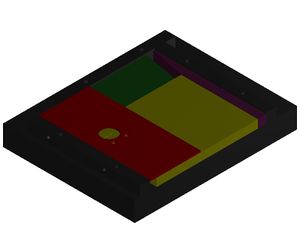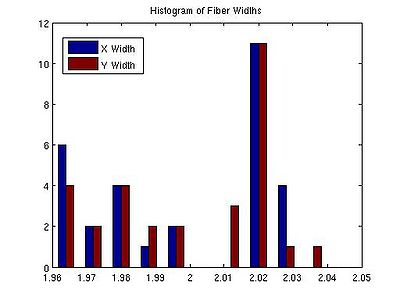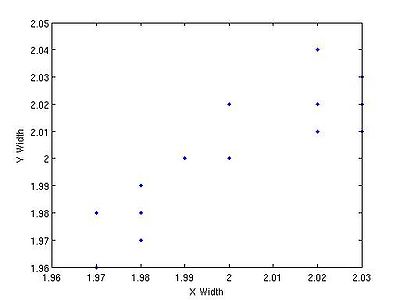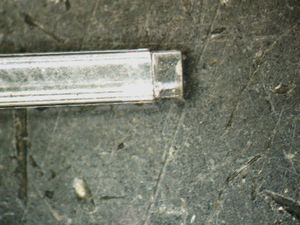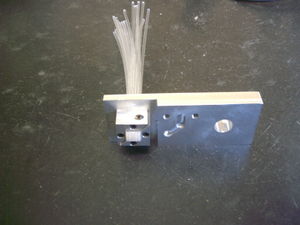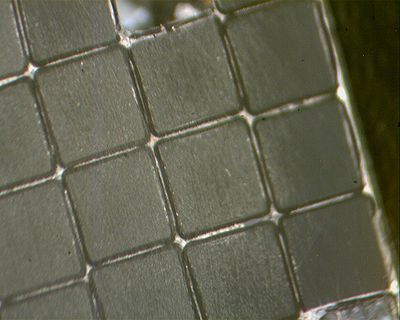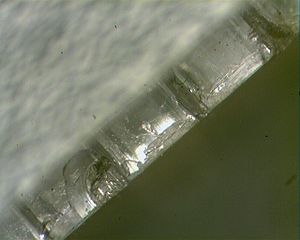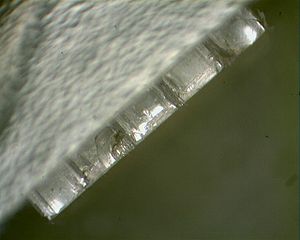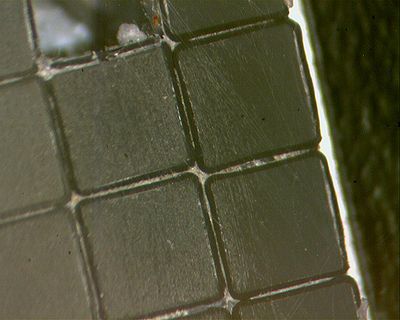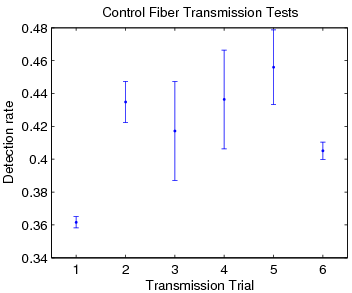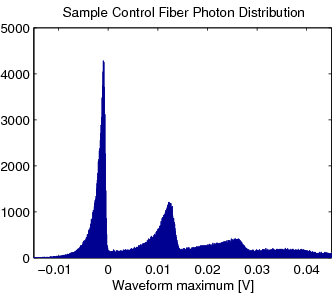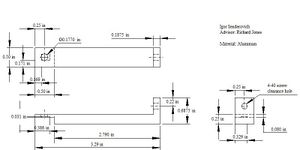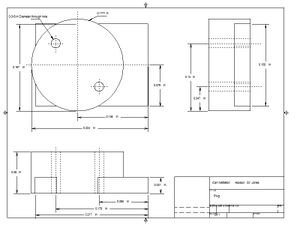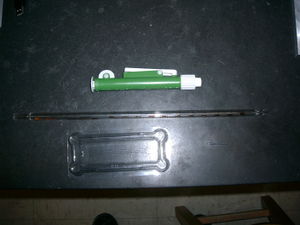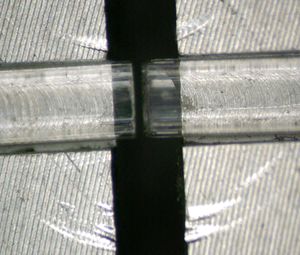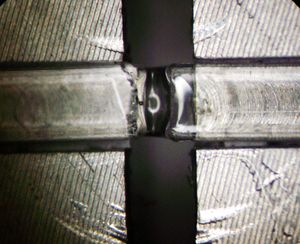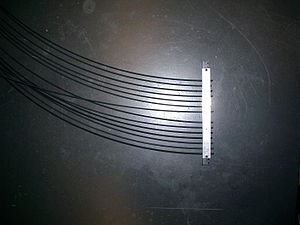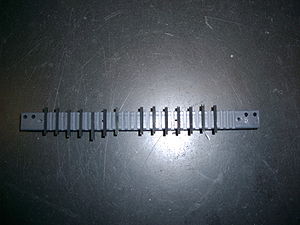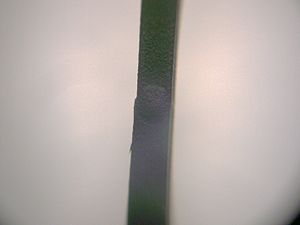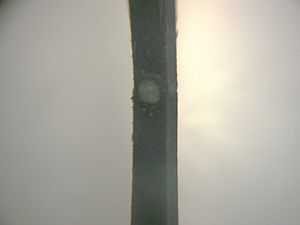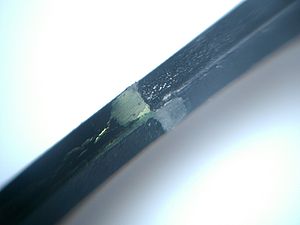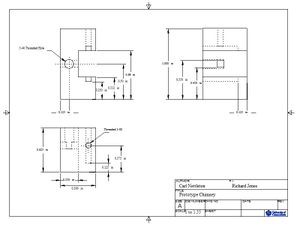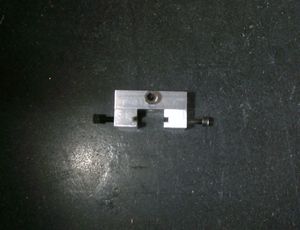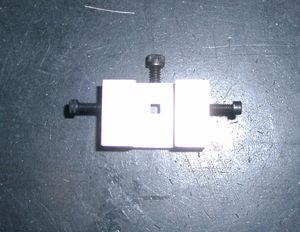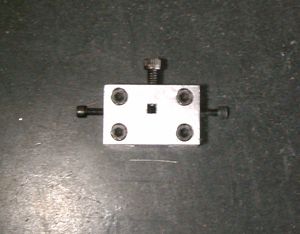Fiber Array Fabrication Techniques
Tools
- We designed our own apparatus to cut, polish, and glue the scintillators and the waveguides. For more information on how it works, see Work Stand Assembly.
- To cut the fibers I use a standard hobby knife.
- For cleaning and polishing acrylic fibers, the recommended tool to use is a plastic nail buff.
- A digital scale (accurate to ±0.01 grams) is used to weigh out the proper proportions of the resin and catalyst.
- Standard laboratory glassware is used for weighing, mixing, and applying the epoxy.
- A laboratory hotplate is used to heat-cure the epoxy.
- An infrared thermometer is used for calibrating the hotplate temperature controls.
For more information (such as prices and product numbers) on the equipment listed above see Supplies
Fiber Research
Fiber Width Variation
To make acrylic optical fibers, Bicron uses the stretch method which involves stretching a mass of material into a long fiber of a specific diameter or width in our case. As a result of this process, there develops minor variations in width along the stretched fiber. Since minor variations in width can compound in to a significant misalignment, I have measured the width distribution of 30 fibers cleaved from the same fiber spool. Below is a histogram of the widths and a plot of the x-axis width vs. the y-axis.
- Note: units of above graphs are millimeters
The results of the measurements revealed a standard deviation of x= 0.0269 y= 0.0244 and a mean of x= 1.9983mm y= 2.0000mm. These small deviations are insignificant and should not cause significant problems in the construction or functionality of the Tagger.
Epoxies
The epoxies that are being tested are:
- BC-600 (Bicron) BC-600 Info
- EJ-500 (Eljen Technology) EJ-500 Info
- 20-3238 (Epoxies Etc) 20-3238 Info
Cleaving and Polishing Techniques
Using Hand Tools
Note: This process assumes that the uncut scintillators and waveguides are in segments or spools of more then 3 meters long. Please read each step completely before you begin this process.
Step 1: Cleaving
- Technique 1
- Place the fiber in the apparatus as shown in Work Stand Assembly under Cleaving. Take the hobby knife and place it on the fiber (again look under Work Stand Assembly for the proper placement of the blade) and gently tap the butt end of the knife until the fiber is cut cleanly. Remove the fiber and inspect the freshly cleaved end. Look for any major breaks in the outer cladding (use magnifying glass if necessary). I will be posting pictures (as they become available) as to what is acceptable and unacceptable breaking in the cladding.
- If the ends of the cleaved scintillators have major breaks in the outer cladding, then the best course of action it to toss out the unusable segment, properly polish the end attached to the spool and repeat Step 1. If the ends of the cleaved scintillators are borderline acceptable proceed to Step 2.
- For the waveguides, it is best to give yourself an extra 1/2 cm of fiber in case the cleaved end has major breaks in the outer cladding.
- Technique 2
- If you want to ensure that the outer cladding will not be disturbed during the polishing process you will need to remove the outer cladding for a short (about 0.5 mm) length of the fiber. This is a relatively easy process; it just takes some time, a lot of patience, and a microscope. To begin with, set up a cutting guide such that you can make a small cut perpendicular to the length of the fiber. If possible try and design your cutting guide such that it also lines up the cuts for all of the sides. I used a simple piece of paper wrapped around the fiber.
- Using the hobby knife, make a shallow cut along your cutting guide. You do not have to cut all the way through the outer cladding, just most of the way. Try not to cut the inner fiber. To ensure that you do not, you might want to practice on some scraps of fiber. Take a piece of scrap fiber and begin cutting the outer cladding. The inner fiber feels much softer than the outer cladding. The only way to learn how to tell the difference is to slowly cut through the test fiber and feel the change in resistance.
- Now that each side of the fiber is cut, start removing the cladding. To do this, it is easiest to use a second hobby knife. Place the second hobby knife along the cut in the fiber and place the initial hobby knife at the end of the fiber between the cladding and the fiber and use it to pry up the cladding. If you did it right the cladding should come up and break along the cut that you made. The fiber after the cladding is removed, is shown in the microscope picture to the right. (Note: don't worry about scratching the inner fiber; it will all be polished away anyway.)
- Finally, during polishing, make sure to buff the fiber almost all the way down to where the cladding begins.
Step 2
- Scintillators: The segments cut using the Work Stand Assembly have an extra millimeter or so in length made by design so that by the end of the polishing process the segment will be of the proper length of 2 cm. That being said, if the fiber is borderline unacceptable, it can still be used provided that enough of the cladding is still intact to leave a sufficient length, once the defective part has been removed by polishing.
- Waveguides: Preparation of the ends of the clear waveguide fibers for gluing is the same as for the scintillating fibers, except that there is somewhat more freedom in the exact length of the finished fiber. If you allot 5 mm extra length when you cut the fiber from the spool then it should be possible to recover through polishing from several failed attempts to produce properly finished ends.
Step 3: Polishing
- Arrange the fiber in the apparatus as shown in Work Stand Assembly under Polishing. If the end to be polished is significantly longer then the desired length (i.e. 0.2 cm or more), begin with the coarse emery board . If total length is less than 0.2 cm of desired length, begin with the much less coarse nail buffs (pictures of the nail buffs will be posted).
- Note: It seems that the color of the nail buffs signifies how fine or coarse the buff is. So if you cannot find the exact nail buffs that I used, just try to match the color of each and you should be fine.
- Using the emery board is a bit tricky and needs special care. Gently grind down the end of the fiber with the board, do not push too hard or to soft. The strokes should be at a steady pace but not too fast or to slow. Considering one up and one down stroke as one complete cycle, the speed should be around 1 revolution per second. I know that these directions are a little obscure, so the best way to figure out just how fast and how much pressure to apply is to use a scrap fiber and practice for yourself. The reason that you do not want to go too fast or apply too much pressure is that excessive grinding speed or pressure results in stripping the outer cladding around the fiber. After the fiber is polished down with the emery board, it is best to remove it from the apparatus and inspect it for major breaks in the outer cladding. The initial grinding process should take about 30 seconds depending on how much you need to shave off.
- Use the nail buffs on the fiber in the order of Black, White, Gray. I used 3 different ones because they came in a set, but if you just use the first (black) and last(gray) I think you should be fine. With these you do not have to be as cautious as with the emery boards, but still some care needs to be taken. Basically follow the same instructions as for the emery board. When you feel, through the buff, the fiber become smooth, it is time to switch to the next buff. Be sure not to over polish the fiber because it will result in rounded-off ends. If the ends are rounded, the epoxy will not adhere properly to the fiber.
- Here are pictures of what the fiber should look like after each step Fiber Pictures
Using Fly Cutter
The Fly Cutter is a milling tool used to shave away layers of a flat surface. For our purposes, the fly cutter is used to cut several fibers at the same time leaving the fiber's ends with a flat and even surface. We designed a "angle clamp" to bundle the fibers together so that we can cut a 5x5 set of fibers with the fly cutter. In the picture to the right, we see the fibers bundled in the angle clamp, the angle clamp itself is attached to a metal piece used to mount the angle clamp in the fly cutter machine. With the fibers secured in the angle clamp, we set the bundle through a few test runs with the fly cutter to determine how fast the blade needs to spin the cut the fibers properly. A rotation speed of 1500 rpms was deemed to produce the best results. In the picture below, we see the fibers after being cut by the fly cutter. Notice the fiber's ends have many small scratches in them but I am confident that those scratches will easily be removed with just a quick polish.
Something that was expected to happen was flaying or stripping of the outer most fiber's cladding. The picture on the right shows a close up view of the outer fibers, on the left a zoomed out view of the same fibers. The cladding is not damaged on all the outer fibers but it is stripped on the majority. All though there was noticeable damage to the cladding, I was surprised to see how well the cladding faired.
The machinists who cut the bundled fibers gave warning about a consequence of using the fly cutter. That is, the interior fibers would become slightly recessed. After a brief test it was determined that the fibers were not recessed significantly enough to be measured by our equipment (i.e the recession would be less then 0.0001 mm off from the plane. Therefore, any recession will not affect any part of the Tagger construction or performance.
Transmission Testing
The main question to be answered by testing the transmission rates is to determine how well we need to polish the fibers. This is done by cutting a 25.625” length of fiber into four segments, gluing those segments back together, testing in the dark box and comparing the results to the control fiber. The segmented fiber will be polished three different ways:
- The first is using only with the emery board leaving a rough polish
- The second adds the use of the three buffer boards
- The third adds stripping the cladding before polishing.
The reason for the multiple cuts of the fibers is to increase the loss of photons. The increased loss of photons will make it easier to identify small changes in the transmission rate between the fibers polished the three different ways.
- Note: This is only testing the relative transmission rates. All percentages of transmission loss is acquired by comparing to the control fiber. Also, the epoxy used for these tests is 20-3238.
- Current Results
We tested the control fiber several times and each time we got a significantly different result. Below we see a histogram of the control fiber whose test length was about 48 hours and a graph comparing the different tests of the control fiber.
As you can see from the graph, there is a large discrepancy between the different tests of the contorl fiber. This could be caused by several things, such as
- The fiber end pointing to the SiPM changes position to dramatically
- The fiber end facing the LED changes position significantly as to change the amount of photons able to transmit through the fiber.
- In changing the fiber, the SiPM could have been disturbed.
- Solution to Problems
(Addressing the problems out of order) We redesigned the "thermal finger" for holding the two different SiPMs. The designs are seen below. The purpose for this is so that the SiPMs can be changed out easily and that we can ensure that the device is in the same position every time.
To ensure that that fiber is in the same position every time in the protochimney, we wrap the end of the fiber in electrical tape (even amounts on all sides). Once wrapped the fiber should fit snugly in the chimney thereby reducing the movement of the fiber. Addressing the remaining problem, we are still working on a proper solution.
Gluing
The gluing process is on-going, so there will be updates to this section.
- Setup:
- There is quite a bit to set up before you begin actually applying epoxy. To start, make sure you have the following supplies:
- Lab Gloves
- Kim wipes
- Digital scale
- Acetone and isopropanol
- A container to mix the epoxy, and a waste container
- The resin and catalyst (or hardener) of the epoxy
- A pipette with tip and dispensing pump
- Tongue depressors
- Once you have collected all the necessary equipment you can begin setting up for gluing. First and foremost, PUT ON GLOVES. Now, take out several kim wipes and place them under the digital scale, the waste container, the resin and catalyst, and on anything that could have unwanted chemicals spilled on. Set 3 or 4 tongue depressors and 3 or 4 pipettes off to the side of your workstation so that they are not in the way but easily accessible. Pour some acetone or isopropanol in your waste container for quick cleaning. Inspect all glassware to make sure that they are completely clean. If you find glassware that is not clean, clean it using acetone and then wait at least 10 minutes before using the glassware. Now that you are all set up you can begin gluing.
- There is quite a bit to set up before you begin actually applying epoxy. To start, make sure you have the following supplies:
Here is a picture of the equipment that is required for the application process.
There have been some additions to the equipment used during and those are seen in the picture below
Gluing a Single Set
- Epoxy 20-3238
- Weigh out your resin and catalyst, this is a MAJOR factor in the success of the experiment so take your time in mixing and getting the exact amounts of resin and catalyst (100 parts resin to 30 parts catalyst).
- Once you have the two components weighed out, mix them together. The mixture should turn mildly opaque and become viscous. When the components are mixed completely, the mixture should turn clear and the viscosity should decrease a bit, becoming more like cooking oil in viscosity.
- There will be bubbles left in the mixture. To get rid of them, just let the mixture sit for about 10 or 15 minutes and the bubbles will come to the surface. Then gently pop the bubbles with a tongue depressor. Now since the pot life of epoxy is 40 to 45 minutes, you will have plenty of time to get rid of the bubbles.
- Once you have the mixed the epoxy, lay the fibers out in the apparatus how you want them to be glued together as shown in the picture to the left. Click on the picture to get a better look at the fibers. Make sure that the ends of the fibers are clean and polished before applying the epoxy. This can and should be done while you wait for the bubbles to escape from the epoxy.
- Now that you have the fibers set and ready to receive the epoxy, take a clean pipette with a dispensing pump and install a tip on the end of the pipette. It is not extremely easy to tell when a tip is completely attached to the end of the pipette, so practice installing pipette tips before running through the entire procedure for the first time.
- With the tip on the pipette, get a small amount of the epoxy in the pipette, and then inject it into the small gap between the two fibers. The final result should look like the picture seen to the right. Click on the photo to see a bigger image.
- Now that the epoxy has been applied, make the final adjustments to the fibers to make sure that they are at the distance desired and that they are lined up properly. All the adjustments should be minor ones, correcting any motion that occurred during the application process. Then let the epoxy cure for 18 to 24 hours at STP, or for 1 to 2 hours at 60 Celsius.
Gluing Multiple Sets
This process is almost identical to the process for gluing a single set of fibers except for a few key differences. The exact same care is required while mixing and handling the epoxy, however, the preparation of and epoxy application to the fibers is quite different.
- The preparation begins with placing all the properly polished fibers/scintillators into the chimneys as seen in the picture to the right. This task, of course, is simple, however there are some important things to keep in mind that will help insure a successful gluing. These things are:
- When placing the waveguides in their chimney, be sure to arrange the fibers so that the ends to be glued are extruding out from the chimney no more then about 3 to 4 mm. The reasoning for this is that the channels in the chimney are wider then the fibers allowing for "wiggle room" and the shorter the amount of fiber sticking out is the less the waveguide will move.
- Once the waveguides are in place screw down the top plate to hold them firmly in place. Then secure the waveguide chimney to a flat surface using c-clamps as seen in the picture below. Add the extra c-clamp in the middle to ensure that the waveguides will not move and are lying flat in the channels.
- The chimney with the scintillators should not be secured with the top plate like the waveguides because during the application process, as will be discussed further down, the scintillators will need to be able to move. However the chimney itself should be secured to the flat surface with the waveguides. (See to the picture above)
- Once both chimneys are secured to the plate, use the tweezers and the watchmaker's loupe 10x to gently slide each of the scintillators up to their waveguide counterpart to make sure that they are aligned properly. Most likely the fibers will not line up exactly. To make major adjustments loosen the clamps holding down the scintillator chimney and move the entire group. For minor adjustments, loosen the extra clamp holding the waveguides and make the adjustments to the fibers using the tweezers. Once every thing is lined up its time to start gluing.
Note: When the fibers are aligned and clamped down it is important not to move, bump, breathe on, etc. because the set up is very sensitive and any disturbance will mean about an hour of extra work.
- For gluing follow the instructions for mixing and pipetting the epoxy. The procedure for applying the epoxy to multiple fibers is very much like the applying to single fiber, that is; inject glue between waveguide and scintillator, gently close the gap between scintillator and waveguide, remove excess run off if there is any, finally verify that the fibers are still in proper alignment. For a single set of fibers this procedure requires some care and delicacy, for multiple fibers the difficulty increases exponentially. One pitfall to beware of is that the epoxy has a pot life of 30 to 45 minutes, and after allowing time to let the bubbles escape for the freshly mixed epoxy leaves only about 20 to 30 minutes before it should be disposed of. This should be enough time to apply the epoxy to all the fibers properly, however, if for whatever reason, one of the waveguide/scintillator pairs are now misaligned, there is not much time to make the necessary adjustments. If making adjustments to misaligned fibers takes too long, separate the problem scintillator from the waveguide but do not try and remove anything from the set as that will most likely disturb the other fiber pairs.
Removing Cured Excess Epoxy
Protochimney
Note: This is not the prototype chimney to be used to couple the matrix of waveguides to the SiPMs. The "protochimney" is to be used in our dark box to couple one fiber to one SiPM. The purpose of this coupling is to test the transmission properties of cleaved fibers joined by different epoxies.
- Below are pictures of the completed protochimney.
